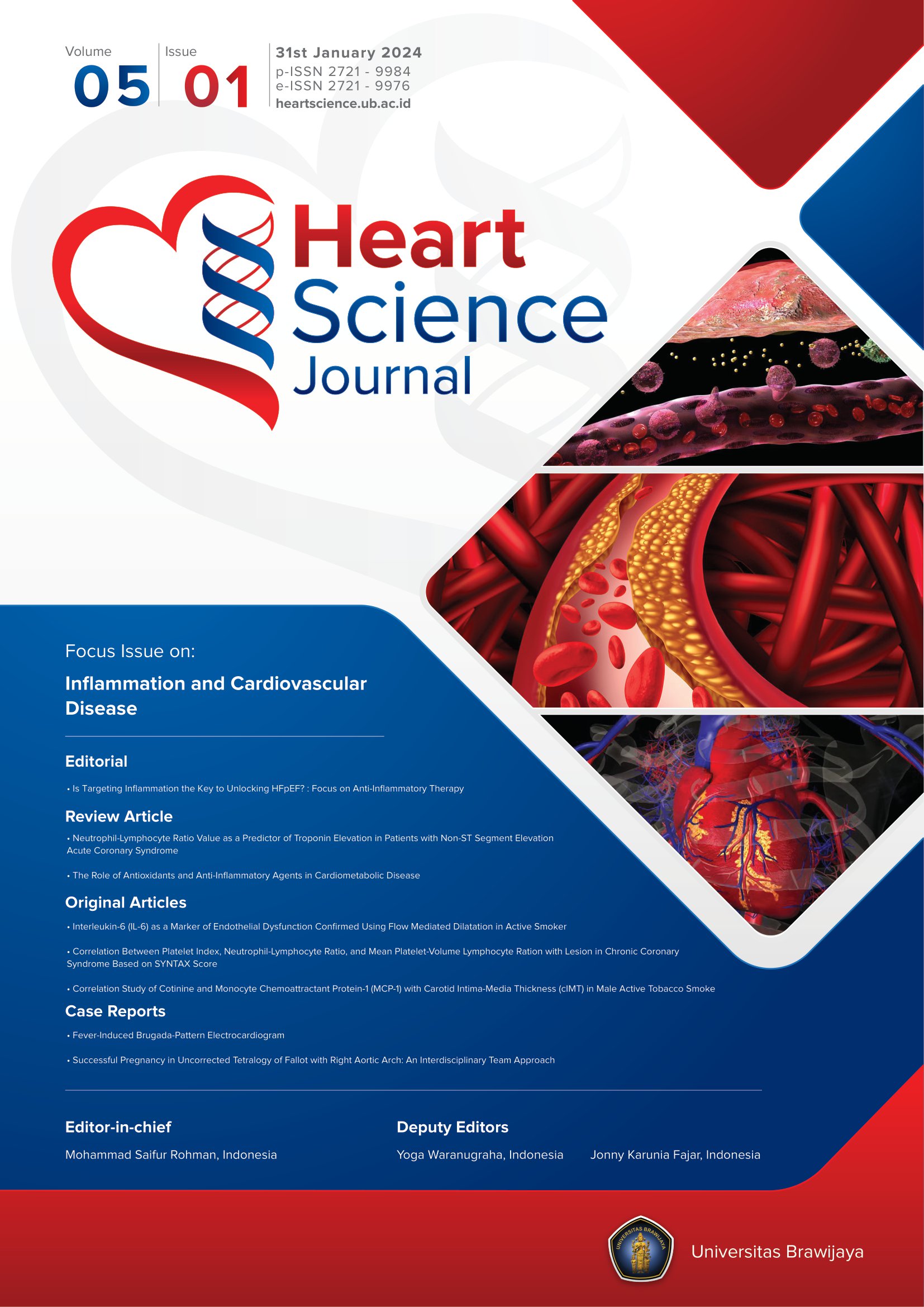Validation of Saiful Anwar Clinical Congestion Score in Comparison with NT-proBNP for Prediction of Short-term Outcome in Acute Heart Failure with Reduced Ejection Fraction
Abstract
Background : Risk stratification of acute heart failure (AHF) patient during hospital admission utilizing clinical scores emerges as an alternative to standart natriuretic peptide measurement. Development of Saiful Anwar clinical congestion score (SACS) as multivariable predictive model for prediction of short-term outcome in AHF with reduced ejection fraction (AHF-rEF) requires validation in comparison to NT-proBNP.
Objective : To validate prognostic value of SACS compare with NT-proBNP in AHF-rEF
Method : This single-center, prospective cohort study was held in dr. Saiful Anwar General Hospital during January 2019 to June 2020. From total 89 AHF-rEF patients who admitted to emergency department, were assigned to SACS prospective questionnaire fulfillment and NT-proBNP measurement during first 12-hours since admission. Patients were divided into two groups based on SACS score and NT-proBNP value during admission. 90-days follow up was performed after index hospitalization with outcome of interest i.e all-cause mortality (ACM) and HF-related rehospitalization (HFR).
Results : ACM and HFR rate in this study were 16.8% and 22.5%, respectively. SACS ≥6 demonstrated higher ACM and HFR rate during 90-days follow-up compared to SACS <6 (p=0.000; p=0.000, respectively). Performance of SACS ≥6 on admission showed good discriminative power for predicting 90-days ACM and HFR (AUC 0.841, p=0.000; AUC 0.788, p=0.000, respectively) compared to NT-proBNP ≥5000pg/mL (AUC 0.812, p=0.000; AUC 0.819, p=0.000, respectively). Additive value of NT-proBNP ≥5000pg/mL on top of SACS ≥6 increases discriminative power for predicting 90-days ACM and HFR after index hospitalization (AUC 0.836, p=0.000; AUC 0.90, p=0.000, respectively).
Comclusion : SACS has demonstrated prognostic value compared to NT-proBNP for prediction of 90-days ACM and HFR after index hospitalization in AHF-rEF patients.Keywords
Full Text:
PDFReferences
Ziaeian B, Fonarow GC. Epidemiology and aetiology of heart failure. Nature Reviews Cardiology 2016; 13(6):368-378.
Badan Penelitian dan Pengembangan Kesehatan Kementerian Kesehatan Republik Indonesia. Laporan Riskesdas 2013. Hal: 90-91.
Rohman MS, Putri DH, Adrian LH, Rusnanta F. 2018. Epidemiologi dan Beban Global Gagal Jantung. Dalam: Buku Ajar Tatalaksana Gagal Jantung Secara Komprehensif. Malang: UB Press.
Ponikowski P, Voors AA, Anker SD, Bueno H, Cleland JGF, Coats AJS, Falk V, Gonzalez-Juanatey JR, Harjola V-P, Jankowska EA. 2016 ESC Guidelines for the diagnosis and treatment of acute and chronic heart failure: The Task Force for the diagnosis and treatment of acute and chronic heart failure of the European Society of Cardiology (ESC) Developed with the special contribution of the Heart Failure Association (HFA) of the ESC. European heart journal 2016; 37(27):2129-2200.
Kitai T, Xanthopoulos A, Tang WHW, Kaji S, Furukawa Y, et al. Validation of the Larissa Heart Failure Risk Score for Risk Stratification in Acute Heart Failure. International Journal of Cardiology 2020; 307: 119-124.
Januzzi JL, Kimmenade K, Lainchbury J, Antoni BG, Lianos JO, et al. NT-proBNP testing for diagnosis and short-term prognosis in acute destabilized heart failure: an international pooled analysis of 1256 patients.European Heart Journal.2006;27:330-337.
Filippatos G, Angermann CE, Carolyn SPL, Cleland JGF, Dahlstrom U, et al. Global Differences in Characteristics, Precipitants and Initial Management of Patients Presenting with Acute Heart Failure – REPORT HF registry. JAMA Cardiol 2020; 8(5): 401-10.
Girerd N, Seronde M, Coiro S, Chouihed T, Bilbault P, et al. Integrative assessment of congestion in heart failure throughout the patient journey. JACC Heart Failure 2018;6(4):273-85.
Nagai T, Sundaram V, Rothnie K, Quint J, Shoaib A, et al. Mortality after admission for heart failure in the UK compared with Japan. Open Heart 2018;5:e000811
Siddiqui WJ, Kohut AR, HAsni SF, Kelepouris E, Eisen HJ, Aggarwal S. 90 days readmission in acute decompensated heart failure – A systematic review and meta-analysis. Journal of Cardiac Failure 2017; 23(8):Suppl S85.
Gheorghiade M, Follath F, Ponikowski P, Barsuk JH, Blair JEA, Cleland JG, Dickstein K, Drazner MH, Fonarow GC, Jaarsma T. Assessing and grading congestion in acute heart failure: a scientific statement from the acute heart failure committee of the heart failure association of the European Society of Cardiology and endorsed by the European Society of Intensive Care Medicine. European journal of heart failure 2010; 12(5):423-433
Mohammed AA, Kimmenade RRJ, Richards M, Pinto Y, Moore SA, Januzzi JL. 2009. Hyponatremia, natriuretic peptides and outcomes in acutely decompensated heart failure. Circ Heart Fail. 2010;3:354-361.
Schefold JC, Lainscak M, Hodoscek L, et al. Single baseline serum creatinine measurements predict mortality in critically ill patients hospitalized for acute heart failure. ESC Heart Failure 2015; 2: 122-128.
DOI: https://doi.org/10.21776/ub.hsj.2020.001.04.06
Refbacks
- There are currently no refbacks.
Copyright (c) 2020 Liemena Harold Adrian

This work is licensed under a Creative Commons Attribution 4.0 International License.









